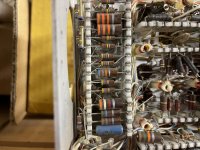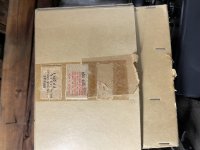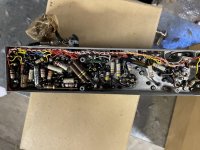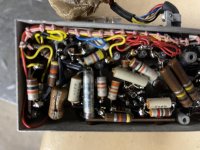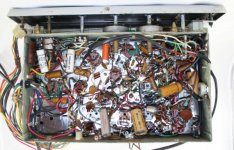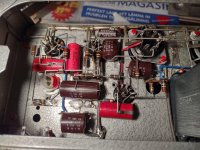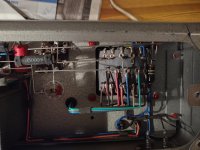Hey guys I didn’t really know what to call this thread, but as I was sacrificing a tektronix plug in module for parts. I thought I should share a few photos.
It also makes me feel that, at times when I wire. I am overly cautious about layout. They run many wires in parallel that are mixed. I always wonder how they kept it so quiet.
Why is that? Is there any particular % of silver that must be used?You have to use silver solder for those ceramic strips.
I have a dead scope that uses them and I've considered trying to re-use them in a project sometime.
Without silver the bond of the metal to the ceramic can degrade. In the old TEK equipment they even provided you with the right solder: https://twitter.com/davbucci/status/804449794978643968
It’s interesting to see how they do it , all so tight. Almost impossible to service
It's called Proper Lead Dress, and is incorporated into how the unit is layed out, designed.
Sadly, in many cases, it's a jungle, and not very "serviceable-friendly".
However, back when "vintage stuff" was manufactured with real quality in mind, servicing was hardly ever needed.
My 1963 RCA Victor console stereo's preamp/tuner chassis was a mess to service, and even the servicing documents contained warnings about how certain parts and wires were to be dressed for good reliable operation.
Have a look at the chassis and you'll see what I mean.
Attachments
Regular solder will crack those ceramic strips. Tek used to include a length of solder inside the scopes for service people.
But isn't modern solder, with silver instead of lead, ok anyway? The issue is that the solder inserts in the ceramic required silver to bond.
Ceramic_Strips
I think it is a lovely story that a ceramics loving company employee, Ted Goodfellow, could have felt sufficiently empowered to develop a radical approach for electronics construction. Wish I worked at a company like that!
Ceramic_Strips
I think it is a lovely story that a ceramics loving company employee, Ted Goodfellow, could have felt sufficiently empowered to develop a radical approach for electronics construction. Wish I worked at a company like that!
I always thought silver solder prevents the silver in these ceramic strips from being alloyed during soldering?
Best regards!
Best regards!
But isn't modern solder, with silver instead of lead, ok anyway? The issue is that the solder inserts in the ceramic required silver to bond.
Ceramic_Strips
I think it is a lovely story that a ceramics loving company employee, Ted Goodfellow, could have felt sufficiently empowered to develop a radical approach for electronics construction. Wish I worked at a company like that!
I use modern solder without lead it works great on these ceramic terminals none have cracked when I have solder them.
Not sure the problem is *cracking* but solder layer on ceramic must be atoms thin.
Best case microns thin.
Silver will dissolve in plain solder, same way as soldering iron copper tips do, leading to pitting.
You have soldered those maybe once or twice.
In the not so long run, silver plating will disappear and plain solder you use now will NOT stick to bare ceramics.
Tek avoided that by supplying silver saturated solder, so it would not absorb any more.
Best case microns thin.
Silver will dissolve in plain solder, same way as soldering iron copper tips do, leading to pitting.
You have soldered those maybe once or twice.
In the not so long run, silver plating will disappear and plain solder you use now will NOT stick to bare ceramics.
Tek avoided that by supplying silver saturated solder, so it would not absorb any more.
"Bouyer" ?If we are looking behind the scenes, how about this beauty ...
It is a French guitar amp
i believe Allen Wright was inspired by Tek scopes, and took both some of the circuit architecture and the point-to-point wiring into his SVP and RTP3 preamps.
Alex
Alex
Those white terminal strips requiring silver doped solder look like what was used in many tubed TEK scopes.
- Home
- Amplifiers
- Tubes / Valves
- Vintage professional and military wiring

